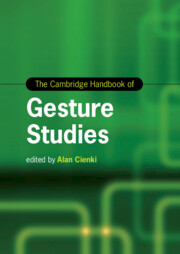Book contents
- The Cambridge Handbook of Gesture Studies
- Cambridge Handbooks in Language and Linguistics
- The Cambridge Handbook of Gesture Studies
- Copyright page
- Contents
- Figures
- Tables
- Contributors
- Introduction
- Part I Gestural Types: Forms and Functions
- Part II Ways of Approaching Gesture Analysis
- Part III Gestures and Language
- Part IV Gestures in Relation to Cognition
- Part V Gestures in Relation to Interaction
- Index
Introduction
Published online by Cambridge University Press: 01 May 2024
- The Cambridge Handbook of Gesture Studies
- Cambridge Handbooks in Language and Linguistics
- The Cambridge Handbook of Gesture Studies
- Copyright page
- Contents
- Figures
- Tables
- Contributors
- Introduction
- Part I Gestural Types: Forms and Functions
- Part II Ways of Approaching Gesture Analysis
- Part III Gestures and Language
- Part IV Gestures in Relation to Cognition
- Part V Gestures in Relation to Interaction
- Index
Summary
The chapters in the handbook cover five main topics. Gesture types in terms of forms and functions; the focus is on manual gestures and their use as emblems, recurrent gestures, pointing gestures, and iconic representational gestures, but attention is also given to facial gestures. Different methods by which gestures have been annotated and analyzed, and different theoretical and methodological approaches, including semiotic analysis. The relation of gesture to language use covers language evolution as well as first and second language acquisition. Gestures in relation to cognition, including an overview of McNeill’s growth point theory. Gestures in interaction, considering variation in gesture use and intersubjectivity. Across the chapters, the meaning of the term ‘gesture’ is itself debated, as is the relation of gesture to language (as multimodal communication or in terms of different semiotic systems). Gesture use is studied based on data from speakers of various languages and cultures, but there is a bias toward European cultures, which remains to be addressed. The handbook provides overviews of the work of some scholars which was previously not widely available in English.
Keywords
- Type
- Chapter
- Information
- The Cambridge Handbook of Gesture Studies , pp. 1 - 4Publisher: Cambridge University PressPrint publication year: 2024

